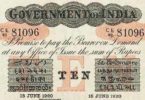Which of the following is the correct statement?
(a) The State Bank of India is the sole authority to issue and manage currency in India
(b) A nationalized bank is the sole authority that issues and manages currency in India.
(c) A cooperative bank is the sole authority that issues and manages currency in India.
(d) RBI is the sole authority that issues and manages currency in India.
Who has the sole right to issue paper currency in India?
(a) The Government of India
(b) The Finance Commission
(c) The Reserve Bank of India
(d) The Central Bank of India
Who amongst the following was never a governor of the RBI?
(a) Bimal Jalan
(b) Y, V. Reddy
(c) Amp Roy Choudhury
(d) C. Rangarajiln
Who is the signatory on the Indian currency notes in the two rupees and above denomination?
(a) Secretary, Reserve Bank of India
(b) Finance Secretary, Minister of Finance
(c) Governor, Reserve Bank of India
(d) Finance Minister, Ministry of Finance
The Reserve Bank of India (RBI) is a bankers’ bank. This would imply which of the following?
1. Other banks retain their deposits with the RBI.
2. The RBI lends funds to the commercial banks in times of need.
3. The RBI advises the commercial banks on monetary matters.
Select the correct answer using the codes given below :
(a) 2 and 3 only
(b) 1 and 2 only
(c) 1 and 3 only
(d) 1, 2 and 3
Related: SEBI quiz
Under which Act has the Banking Ombudsman been constituted?
(a) Banking Regulation Act
(b) RBI Act
(c) SBI Act
(d) COPRA
The symbol of the Reserve Bank of India is
(a) Capital of Asokan Pillar
(b) Kuber with a purse of money
(c) Tiger before a Palm tree
(d) A dog sitting in a defensive state
The RBI was originally constituted as a shareholder bank with a share capital of __
(a) 50 lakh
(b) 100 lakh
(c) Ten crore
(d) Five crore
Banks borrow money from the RBI on which of the following rates?
(a) Reverse Repo Rate
(b) Repo Rate
(c) Savings Rate
(d) SLR and CRR
Which of the following statements about a Reserve Bank of India (RBI) directive to banks on repayment of home loans is/are correct?
(a) Banks cannot charge penalty on pre-payment of home loans
(b) The rate of penalty charged by all banks on pre-payment of home loans must be the same
(c) RBI will determine the rate of penalty charged by banks on pre-payment of home loans
(d) Penalty charged by banks on pre-payment of home loans should depend on the amount and tenure of the loan
Related: major Indian political parties
Under Section 19 of the Reserve Bank of India Act, 1934, the RBI has been prohibited.
(a) making loans or advances
(b) drawing or accepting bills payable otherwise than on demand
(c) allowing interest on deposits or current accounts
(d) All of these
All banks in India get major policy decisions/ directives/guidelines related to their day-to-day operations from
(a) Ministry of Home Affairs, Government of India
(b) Securities and Exchange Board of India
(c) Reserve Bank of India
(d) All India Bank Employees Union
The Head of the Reserve Bank of India is designated as the.
(a) Chief Executive Officer
(b) Managing Director
(c) Chief Banking Officer
(d) Governor
The first bank established in India was __
(a) Bank of Bengal
(b) Bank of Hindustan
(c) Allahabad Bank
(d) Punjab National Bank
RBI’s Department of Currency Management is located at
(a) Mumbai
(b) New Delhi
(c) Pune
(d) Bengaluru
Related: ancient India questions
Which of the following is/are the measure(s) taken by the Reserve Bank of India to ease the liquidity crunch in the country?
(A) Cut in Cash Reserve Ratio and Statutory Liquidity Ratio.
(B) Increase the flow of foreign direct investment.
(C) Supply of additional currency notes in the market.
(a) Only (A)
(b) Only (B)
(c) Only (C)
(d) All (A), (B) & (C)
Who is authorized to issue coins in India?
(a) RBI
(b) Ministry of finance
(c) SBI
RBI notifies CRR under _________ Act
(a) Section 24 of the Banking Regulation Act
(b) Section 42 of the Banking Regulation Act
(c) Section 24 of the RBI Act
(d) Section 42 of the RBI Act
Coins are minted at the four mints located
(a) Mumbai, Noida, Kolkata and Chennai
(b) Nashik, Dewas, Mysore and Bengaluru
(c) Mumbai, Noida, Kolkata and Hyderabad
(d) Nashik, Dewas, Mysore and Salboni
The Reserve Bank of India does NOT decide the _____
(a) Rate of Repo and Reverse Repo
(b) Marginal Standing Facility Rates
(c) Bank Rate
(d) Rate of Dearness Allowance to Govt. Employees
Related: Essential of Bailment
Reserve Bank of India was nationalized in ___.
(a) 1941
(b) 1942
(c) 1945
(d) 1949
Under Section 17 of the Reserve Bank of India Act, 1934, the central bank is involved in
(a) Selling of Government Securities
(b) Issuing & accepting of Promissory notes
(c) Emergency loans to banks
(d) Issuing of Currency notes
What is the Repo Rate?
(a) It is the rate at which RBI sells government securities to banks.
(b) It is the rate banks borrow rupees from RBI.
(c) It is the rate RBI allows small loans in the market.
(d) It is the rate which banks offer to their most valued customers or prime customers
Which of the following tools is frequently used by the RBI to control credit and monetary situations in the country’s markets?
(a) Forward Rate Agreements (FRA)
(b) Cash Reserve Ratio (CRR)
(c) Real Time Gross Settlement (RTGS)
(d) Electronic Clearing Service (ECS)
Which rates signal the RBI’s long-term outlook on interest rates?
(a) Repo Rate
(b) Bank Rate
(c) SLR
(d) Reverse Repo Kate
Related: Objectives of ESI Act 1948
Which of the following is one of the core functions of the Reserve Bank of India?
(a) To act as Tax collector of the Govt. of India
(b) Help in the finalization of the Union Budget
(c) Participate in annual meetings of the various financial institutes worldwide
(d) Work as a Banker to the Banks
The percentage of deposits of commercial banks statutorily kept with the RBI is :
(a) Cash Reserve Ratio
(b) Statutory Liquidity Ratio
(c) Repo Rate
These are short-term securities issued by the RBI on behalf of the government of India:
(a) Trade bill
(b) Hundis
(c) Treasury bills
All over the world, banking and financial services are usually regulated by the Monetary Authority of the land. Who controls this function in India?
(a) IRDA
(b) SEBI
(c) RBI
(d) FEDAI
Related: GST Questions / Answers
What do the open market operations of the RBI mean?
(a) Buying and selling shares
(b) Auctioning of foreign exchange
(c) Trading in securities
(d) Transactions in gold
The Reserve Bank of India
(a) provides direct fiancee to agriculture
(b) Provides finance to primary cooperative societies
(c) Provides finance to state cooperative banks
(d) Does not provide finance to agriculture
The RBI issues currency notes under the
(a) Fixed Fiduciary System
(b) Maximum Fiduciary System
(c) Fixed Minimum Reserve System
(d) Proportional Reserve System
This refers to the market for government and semi-government securities backed by the RBI:
(a) Money market
(b) Capital market
(c) Gilt-edged market
Holidays are declared to the banks under
(a) Central Bank Association Act
(b) Banking Regulation Act
(c) Negotiable Instrument Act
(d) Indian Contracts Act
Related: mcq on banking
The symbol of the Reserve Bank of India is
(a) Capitol of Asokan Pillar
(b) Kuber with a purse of money
(c) Tiger before a Palm tree
(d) A dog sitting in a defensive state






